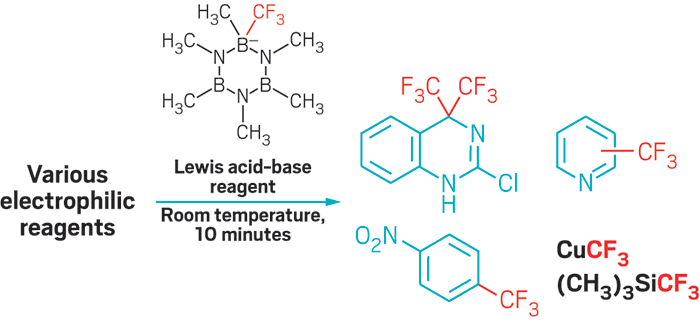Advertisement
Grab your lab coat. Let's get started
Welcome!
Welcome!
Create an account below to get 6 C&EN articles per month, receive newsletters and more - all free.
It seems this is your first time logging in online. Please enter the following information to continue.
As an ACS member you automatically get access to this site. All we need is few more details to create your reading experience.
Not you? Sign in with a different account.
Not you? Sign in with a different account.
ERROR 1
ERROR 1
ERROR 2
ERROR 2
ERROR 2
ERROR 2
ERROR 2
Password and Confirm password must match.
If you have an ACS member number, please enter it here so we can link this account to your membership. (optional)
ERROR 2
ACS values your privacy. By submitting your information, you are gaining access to C&EN and subscribing to our weekly newsletter. We use the information you provide to make your reading experience better, and we will never sell your data to third party members.
Synthesis
Taming Fluoroform
Synthetic Methods: Chemists refine approach for using a waste greenhouse gas
by Stephen K. Ritter
December 10, 2012
| A version of this story appeared in
Volume 90, Issue 50
After years of trial and error, chemists may finally have developed a general method to elevate fluoroform, CF3H, from a useless and problematic chemical by-product into a feedstock for making pharmaceuticals and agrochemicals.
Processes to make nonstick coatings, refrigerants, insulation for electrical wiring, and stain-resistant fabrics generate tons of unwanted CF3H each year. The nontoxic gas has a low impact on the ozone layer, but it’s a potent greenhouse gas. Chemical companies have faced the choice of spending money to decompose the chemical or storing it away indefinitely in tanks.
G. K. Surya Prakash and coworkers at the University of Southern California have now figured out the precise conditions needed to allow chemists to use inert CF3H to transfer CF3 groups to a variety of molecules (Science, DOI: 10.1126/science.1227859). They found that a particular base, potassium hexamethyldisilazide, is required to optimally activate the C–H bond of fluoroform. Selecting the right organic solvent, typically tetrahydrofuran, is also important.
In one reaction, the USC researchers added elemental sulfur to CF3H to make trifluoromethanesulfonic acid, CF3SO3H. It’s one of the strongest acids known and widely used, for example, as a catalyst.
In another, the team combined CF3H with various trialkylsilyl chlorides to make trifluoromethylsilanes. One of these compounds, (CH3)3SiCF3, known as the Ruppert-Prakash reagent, is a popular trifluoromethylating reagent. The researchers also treated CF3H with trialkyl borates to prepare CF3BF3K, a salt useful in trifluoromethylation reactions.
In addition, the team took a crack at using CF3H for direct trifluoromethylations of carbonyl groups in a variety of ketones, aldehydes, formate esters, and other compounds, achieving modest yields.
Using CF3H is potentially an inexpensive way for chemists to introduce CF3 groups into their target molecules, notes Thomas M. Stevenson, a research fellow at DuPont Crop Protection. As a gas, it is less convenient for small-scale lab work, he says, but it might be a big deal for manufacturing.
“Certainly this work is not the first use of fluoroform, but it does have the broadest scope of utility,” Stevenson adds. “It will be of interest to the wider community of organic chemists.”






Join the conversation
Contact the reporter
Submit a Letter to the Editor for publication
Engage with us on Twitter